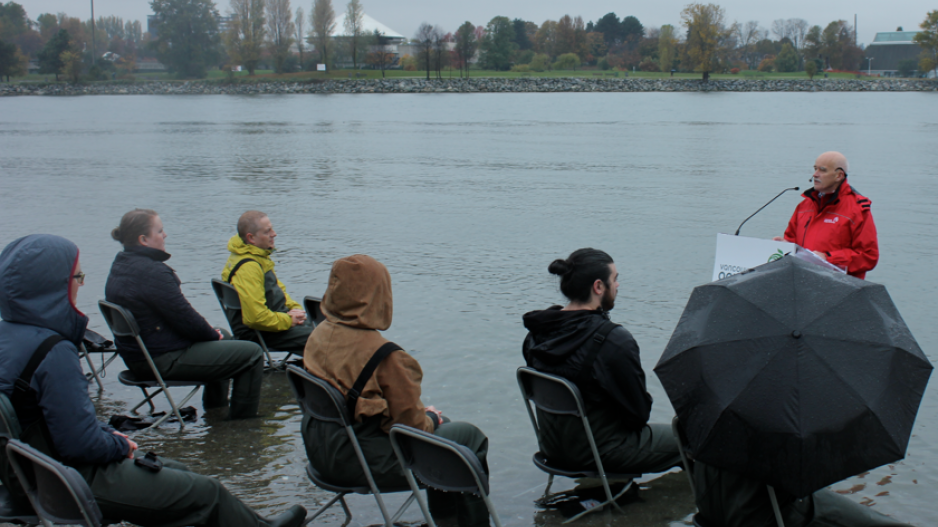Canada’s north might seem very far away from Vancouver, but the Vancouver Aquarium wants you to think about it.
“Sea level rise is just one of the monumental changes going on in the world’s arctic and Canada’s arctic,” said John Nightingale, president and CEO of the Vancouver Aquarium, wearing hipwaders and to standing in water up to his knees at Vancouver’s Sunset Beach.
The publicity stunt — which also featured chairs for the audience partly submerged in the surf — was intended to promote the aquarium’s research in the arctic, which includes studying whales and sea ice.
The United Nation’s Intergovernmental Panel on Climate Change predicts sea levels to rise by three feet, or 0.9 metres, by 2100. But some scientists have warned sea level rise could be much more dramatic if ice fields in the Antarctic and Greenland start to melt at a much faster rate.
The B.C. government is currently planning for a one-metre sea level rise by 2100.
“When sea ice melts it doesn’t actually raise the sea level, it’s when the glaciers melt,” Nightingale explained. “To get an idea of the size, the Greenland ice field is about three times the size of Texas.
“So if the Greenland ice cap were to melt entirely, along with the glaciers in Canada, you’re looking at six or seven-metre rise in sea level. That’s not going to happen in the next few years. But both sea ice melting and ice cap melting reached a peak in terms of melt in 2012 and … this year was the third or fourth worst year in terms of minimum ice cap cover.”
Nightingale warned that as the ice retreats, Canada's arctic will be under greater pressure for oil and mineral extraction and for arctic waters to be used as a shipping route.
Earlier this week, Brian Menounos, a geography professor and glacier researcher at the University of Northern British Columbia , told media that B.C.’s glaciers melted much faster in 2015 than in previous years.
Scientists are currently trying to determine the rate at which Greenland’s ice sheet is melting.
In a 2011 report, Eileen Keenan and Andy Yan modeled the risk of flooding for Vancouver with one-to-6 level metres of affected area, in the event of a very high spring tide combined with a severe storm.
Farmers in Richmond, who use water for irrigation from the Fraser River, are already seeing the effects of sea level rise in combination with lower spring runoffs as mountain snowpacks are reduced or non-existent.
In 2014, a B.C. government report called for most of the existing dikes along the Fraser River to be upgraded, at an estimated cost of $9.5 billion, because of increased flooding risk due to sea level rise.
@jenstden




